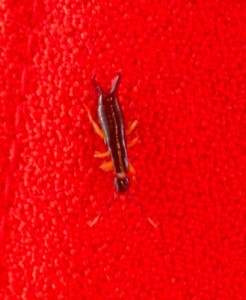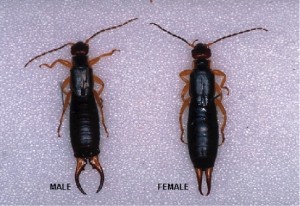It was an ordinary Tuesday afternoon, and I was doing my homework on the orange couches in the McMurtry commons. When dinnertime came around I decided to pack my things and then head over to cheer practice, but something else decided to make moves as well. On the bright orange cushions there was a curious insect, Euborellia annulipes (Lucas) also known as the ring-legged earwig crawling out of the crevices. While my best friend called me gross and whined “eew” a bunch of times, I was eagerly trying to get a clear photo of the earwig using my iphone.
Photo by Alyssa Thomas
So why was there an earwig inside the commons and how did it get there? Well this species has been identified in the United States since 1902. They are nocturnal and are commonly found outside beneath stones or in hidden areas; contrary to the belief that they crawl into human ears to lay their eggs. They prefer temperate or tropical environments, which means they tend to migrate indoors when it is too hot and dry outside. This may be the reason why I found one hidden in the air-conditioned common area. I figured that he was possibly waking up to eat some food like the rest of McMurtry students, which is why I did not see him come out until it was about 6:30p.m.
However, earwigs prefer to eat other insects dead or alive, which may be equivalent to the servery food on certain occasions. They are also known to feed on plants. These harmless pests do not quite bite, but they do have enlarged cerci used as forceps to protect them from other insects and mating.
Photo by Professor Miller
Their cerci is important in determining the sex. I was referring to the individual that I found as “he” because his cerci were more curved and spread out, which is indicative of the male. The female receives sperm from the male after interacting using their cerci. She holds the sperm until she is ready for them to be fertilized. The nymphs are born wingless and undergo simple metamorphosis.
Female earwigs are known to show maternal care, which is uncommon in insects. An article here explains how there was research done a few years ago about how mother earwigs favor their most-fit children. It is pretty selfish and not something done with most human relationships, but they are simply allocating their resources properly. It was found that the healthy babies emit a chemical signal that attracts the mother. Once she has signaled out her favorite kids, she simply regurgitates her food to nurse them.
So now you know why your older brother always got the new stuff while you had to settle for the hand-me-downs, your mom just wanted to invest all her time and resources to raise him perfectly since he was her first child. Anyways, don’t cover your ears from earwigs, but get to know them!


